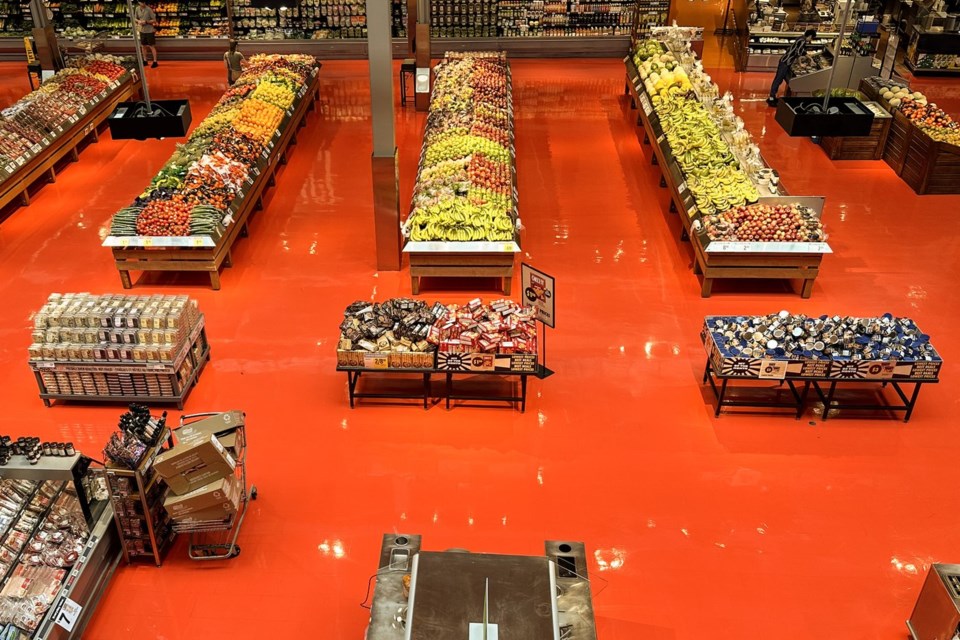Loblaw Cos. Ltd. says it's still working to stock its grocery store shelves with more Canadian products as shoppers look for local alternatives during the Canada-U.S. trade war, but the company's chief executive admits the shift may not last.
"We recognize that Canadians care deeply about the region of the product they purchase and we continue to actually seek out Canadian growers and manufacturers for the products we sell," Loblaw president and CEO Per Bank told analysts on a conference call Wednesday, as the company reported its first-quarter profit rose compared with a year ago.
While Bank said it's difficult to gauge consumer preferences in-store, data from Loblaw's online grocery service shows a clear pivot by shoppers toward the "Buy Canadian" movement that has gained momentum since U.S. tariffs went into effect.
He said less than four per cent of PC and No Name brand products come from the U.S.
"Just before this meeting, I was down in the test kitchen and I was observing that they are testing a lot of new products," Bank said.
"They have been really, really busy to help mitigate the tariff situation so we can buy less from the U.S."
With tariffs adding to pressure on the cost of some food items and other essentials, Bank said the grocery retailer is "working diligently to keep prices as low as possible."
Earlier this year, Loblaw began highlighting domestic products in its stores while also marking products that have seen price hikes due to tariffs. It also added a "swap and shop" feature to its loyalty app to help shoppers find Canadian products more easily.
Asked if he anticipates the "Buy Canadian" trend will persist, Bank said he was hopeful, but predicted that "maybe a third of it will stick" long term. He said price and quality are still the most important factors customers consider when choosing which products to buy.
"If price and quality is best (for) a Canadian product, then they choose those, but if it's a foreign product, they will choose that," said Bank.
"Right now, they prefer Canadian products. I would say if the price is almost the same, like up to five per cent different, then customers buy Canadian, so I hope it sticks."
The parent company of Loblaws and Shoppers Drug Mart said it also continued seeing strong customer response to loyalty offers and promotions during the quarter.
Its net earnings available to common shareholders amounted to $503 million or $1.66 per diluted share for the quarter ended March 22. The result was up from a profit of $459 million or $1.47 per diluted share in the first quarter of 2024.
On an adjusted basis, Loblaw says it earned $1.88 per diluted share in its latest quarter, up from an adjusted profit of $1.72 per diluted share a year earlier.
Analysts on average had expected an adjusted profit of $1.87 per diluted share, according to LSEG Data & Analytics.
RBC analyst Irene Nattel called it "another solid quarter" for Loblaw, saying its key performance indicators were generally in line with expectations. She said that points to sustained momentum for the company.
Revenue for the quarter totalled $14.1 billion, up from $13.6 billion, as food retail same-store sales rose 2.2 per cent. Drug retail same-store sales rose 3.8 per cent, with pharmacy and health care services same-store sales up 6.4 per cent, and front store same-store sales increasing 0.9 per cent.
In February, Loblaw announced plans to spend $2.2 billion in 2025 to open 80 new grocery stores and pharmacies with about 50 of them being discount grocers. Bank had said many would be smaller-format stores, building the company's network of those types of grocers after launching small-format No Frills stores for the first time last May.
Ten of those stores opened last quarter with the same amount planned for the second quarter, while the remaining 60 will open in the second half of this year.
Bank said the company is encouraged by the early performance of its newest locations, with the majority "living up to our expectations."
"If the new stores wouldn't be working, then I would not open one more store," he said.
"So the moment we see it won't work, then of course we will stop building new stores. But trust me, that will work the next five years because customers, they're asking for lower prices, they're asking for hard discounts."
The investment, which is part of about $10 billion over five years, will also add 100 pharmacy care clinics to the company's network. Loblaw opened 52 new stores in 2024 as well as 78 new clinics.
Loblaw also said Wednesday that its dividend rose to 56.4 cents per common share, an increase of 10 per cent, marking the 14th consecutive year of dividend increases.
This report by The Canadian Press was first published April 30, 2025.
Companies in this story: (TSX:L)
Sammy Hudes, The Canadian Press




